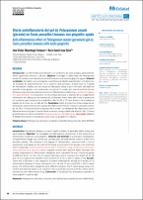Efecto antinflamatorio del gel de Pelargonium zonale (geranio) en Cavia porcellus Linnaeus con gingivitis aguda
Related Resource(s)
https://rpmi.pe/index.php/rpmi/article/view/35Date
2021-12-22Author(s)
Manchego Enríquez, José
Jayo Silva, Karin Janet
Metadata
Show full item recordAlternate title
Anti-inflammatory effect of Pelargonium zonale (geranium) gel on Cavia porcellus Linnaeus with acute gingivitis
Abstract
Introducción: La enfermedad periodontal es un problema de salud pública, generalmente afecta apacientes jóvenes y adultos. Objetivo: Investigar la efectividad del Pelargonium zonale (P. zonale) en el tratamiento de la inflamación relacionada a gingivitis aguda. Material y métodos: Se realizó una investigación cuantitativa de diseño experimental, se trabajó con 18 animales de experimentación, de la especie Cavia porcellus. El desenlace es el grado de inflamación, medida con una escala de valoración clínica a partir del color del tejido de acuerdo a tres grupos, uno tratamiento con gel de P. zonale, otro control positivo con un fármaco comercial compuesto por neomicina, hidrocortisona y lidocaína; y un control negativo con agua destilada. Se compararon las frecuencias absolutas y relativas de las categorías de inflamación de cada grupo de tratamiento a diferentes horas. Para ello se usó la prueba de chi cuadrado para comparar los resultados a las 24, 48 y 72 horas frente a las mediciones basales de 4 horas, con un alfa del 5%. Resultados: Hubo disminución de las categorías de inflamación severa entre las frecuencias de inflamación entre las 4 horas en comparación con las 24, 48 y 72 horas (p<0,05) en el grupo de P. zonale. Las categorías de inflamación fueron diferentes entre el grupo P. zonale frente al control con agua destilada a las 24, 48 y 72 horas (p<0,05); pero no con el control del fármaco comercial antiinflamatorio. Conclusión: El gel de P. zonale tiene potencial terapéutico para tratar las gingivitis en cobayos. Introduction: Periodontal disease is a public health problem; it generally affects young and
adult patients. Objective: To investigate the effectiveness of geranium in the treatment of
inflammation related to acute gingivitis. Material and methods: A quantitative investigation
of experimental design was carried out, working with 18 experimental animals of the Cavia
porcellus species. The outcome is the degree of inflammation, measured with a clinical
assessment scale based on the color of the tissue according to three groups, one treatment
with P. zonale gel, another positive control with a commercial drug composed of neomycin,
hydrocortisone and lidocaine; and a negative control with distilled water. Absolute and
relative frequencies of inflammation categories were compared for each treatment group
at different times. For this, the chi square test was used to compare the results at 24, 48
and 72 hours against the baseline measurements of 4 hours, with an alpha of 5%. Results:
There was a decrease in the categories of severe inflammation among the frequencies of
inflammation between 4 hours compared to 24, 48 and 72 hours (p<0.05) in the P. zonale
group. The inflammation categories were different between the P. zonale group versus the
control with distilled water at 24, 48 and 72 hours (p<0.05); but not with the control of the
commercial anti-inflammatory drug. Conclusion: P. zonale gel has therapeutic potential to
treat gingivitis in guinea pigs.






